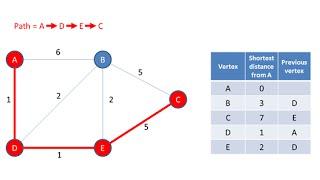
Graph Data Structure 4. Dijkstra’s Shortest Path Algorithm
Комментарии:

saved my damn ass before exam lol
Ответить
it's funny because for a moment, I thought you said "Dijsktra's algorithm creates disinformation" and then I realized I'm spending too much time with politics.
Ответить
الله يجعلك مسلم و يدخلك الجنة
Ответить
Phenomenal video, nothing else has to be said.
Ответить
ah shii the finalized prev vertex column makes D E A D
welp i guess dude is tryin to tell me something...

Best video on Dijkstra's by a considerable margin. Subbed.
Ответить
Amazing!!!!!!!
Ответить
Tomorrow I have my exams on this topic.. This is the best video about djkstras algorithm on whole internet
Ответить
So easy to follow. Best video I’ve seen on this algorithm
Ответить
I haven't found a better tutorial than this for understanding and computing distances using Dijkstra's algorithm. Thank you so much.
Ответить
Nah. Not working for all graphs. It's have to be cycle graph. usless
Ответить
Thank you for this amazing video!
Ответить
This is by far the best video I've seen on this algorithm. It is clear and doesn't skip any steps.
Ответить
Thank you. You are my Professor. Not my actual professor
Ответить
Thank you for helping students ❤
Ответить
Note: If you change the criteria to select the next node to visit, you can no longer skip already visited nodes while iterating. Choosing the shortest path in each step ensures that visited nodes have the best path for the rest of the calculation
Ответить
Wow it's an honor to be learning this from Computer Science itself
Ответить
You saved my exam thank you so much!!
Ответить
thanks❤
Ответить
Great video, many thanks!
Ответить
thank you sir for your service
Ответить
im gonna cry i dont get it still
Ответить
so instead of saying unkown we say infinity got it. if someone asks me what is the distance to the closes restroom i can reply with infinity. can you even imagine how dumb that sound.
Ответить
What if the graph contains one vertex that might be not visited?
Ответить
best djikstra explanation
Ответить
holy shit watching this is a revelation
Ответить
You are the KING THE SAVIOUR OF ALL CS MAJORS THANK GOD YOU MADE THIS VIDEO!!!!!!!!!!!!!!!!!!!!!!!!!!!!!!!!!!
Ответить
beautifully explained.
Ответить
the parent column spells out DEAD 😂, love your humor
Ответить
Thank you so much!!! Did not understand this. Now I do :)
Ответить
His previous distant is “DEAD”
Ответить
Thanks
Ответить
THE BEST !!!
Ответить
Khalid35😂😂😊😊😊🎉
Ответить
clear and comprehensive, thanks.
Ответить
THANK. YOU.
Ответить
I have a problem{ we can directly visit from A to D to E and to C which is = 7} which is the shortest one instead of going from A to D to E to B and then C which is = 9 can someone explain it please
Ответить
I've watched this the time it was uploaded. I've no idea what it was but I still passed the CCNP exams and found a good job. Now 8 years after that, I fully understand what a priority queue is and what a great man Mr. Dijkstra is, yet I cannot find a decent job and have been unemployed for over a year.
Ответить
Thank you so much! Great explanation.
Ответить
If you want to find the shortest distance from A to C, how do you know that the algorithm will take you to the latter vertex? Maybe it will end before you have reached your disered destination, or maybe it will not end at all but go on forever.
Ответить
Finally, it took me almost a whole week to get it, finally I understood enough to build this damn thing myself. REALLY appreciate it, man. If I knew how to recommend videos to The Odin Project as learning reference, you would be there.
Ответить
So basically start from source node :
Then check both of its children and calculate shortest distance of each and previous vertex . Remove source vertex from unvisited nodes and add it to visited nodes .Then pick node with smallest shortest distance and do the same thing again (it will be your source node). When calculating distance add previous distance of current node.However if that node gets a shorter distance to an existing node update that node in table .
Repeat

Great
Ответить
thank you so much for the best explanation!! learnt this better than my lecture slides easily
Ответить
It's a fictional visualisation because there is not any such square which can have different side lengths, a diagonal smaller than its side length. A lot of nonsense in CS has been ignorantly blindly spread and copied
Ответить
I watched this video when I was doing my A levels, I watched it during my first year of university. And here I am watching it again in my second year of university. I think this algorithm is never going to stick in my mind and I am always destined to forget it. Thanks for your video I've been literally using it for three years now.
Ответить
goated fr
Ответить



























